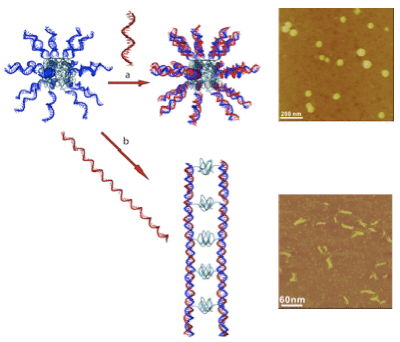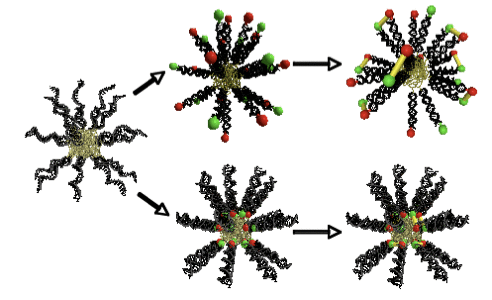
Fikri Alemdaroglu joined the Max Planck Institute for Polymer Research in the beginning of 2004 as a PhD student. In the framework of SONS Program he has worked on the preparation and application of organic hybrid structures consisting of DNA and synthetic polymers.
Different synthetic strategies based on grafting onto routes in solution or on solid support were developed which afforded DNA block copolymers with hydrophilic, hydrophobic and thermoresponsive organic polymers in good yields.[1, 2] Beside the preparation of DNA block copolymers with a relative short DNA-segment, it was also demonstrated how these bioorganic polymers can be synthesized exhibiting large DNA blocks (>1000 bases) applying the polymerase chain reaction.[3] Amphiphilic DNA block copolymers, which were synthesized fully automated in a DNA synthesizer, self-assemble into well-defined nanoparticles. Hybridization of spherical micelles with long DNA templates that encode several times the sequence of the micelle corona induced a transformation into rod-like micelles.[4] The Watson-Crick motif aligned the hydrophobic polymer segments along the DNA double helix, which resulted in selective dimer formation (Figure 1). Even the length of the resulting nanostructures could be precisely adjusted by the number of nucleotides of the templates.

Figure 1. Preparation of nanoparticles with different shapes. a) Base pairing of micelles with a short complementary sequence yields micelles with a ds corona maintaining the overall spherical shape of the aggregates. b) Hybridization with long DNA templates results in rodlike micelles consisting of two parallel aligned double helices.
In addition to changing the structural properties of DNA-b-PPO micelles, these materials were applied as 3D nanoscopic scaffolds for organic reactions.[5] The DNA strands of the corona were organized by hydrophobic interactions of the organic polymer segments in such a fashion that several DNA-templated organic reactions proceeded in a sequence specific manner; either at the surface of the micelles or at the interface between the biological and the organic polymer blocks (Figure 2). The yields of reactions employing the micellar template were equivalent or better than existing template architectures.

Figure 2. Schematic representation of DNA-templated synthesis applying DNA block copolymers. Single stranded micelles can be either hybridized with oligonucleotides that are equipped with reactants at the 5’ (a) and 3’ ends (b). The subsequent chemical reaction proceeds at the rim of the micelle or at the hydrophobic/hydrophilic interface, respectively.
Aside from its physical properties and the morphologies achieved, an important requirement for a new biomaterial is its biocompatibility and interaction with living systems, i.e. human cells. The toxicity of the nanoparticles was analyzed by a cell proliferation assay. Motivated by the non-toxic nature of the amphiphilic DNA block copolymers, these nanoobjects were employed as drug delivery vehicles to target the anticancer drug to a tumor tissue.[6] The micelles obtained from DNA block copolymers were easily functionalized with targeting units by hybridization.
The results of his research have been published in the following journals:
[1] F. E. Alemdaroglu and A. Herrmann, Org. Biomol. Chem. 2007, 5, 1311-1320.
[2] F. E. Alemdaroglu, M. Safak, J. Wang, R. Berger and A. Herrmann, Chem. Commun. 2007, 13, 1358-1359.
[3] M. Safak, F. E. Alemdaroglu, Y. Li, E. Ergen and A. Herrmann, Adv. Mater. 2007, 19, 1499-1505.
[4] K. Ding, F. E. Alemdaroglu, M. Boersch, R. Berger and A. Herrmann, Angew. Chem. Int. Ed. 2007, 46, 1172-1175.
[5] F. E. Alemdaroglu, K. Ding, R. Berger and A. Herrmann, Angew. Chem. Int. Ed. 2006, 45, 4206-4210.
[6] F. E. Alemdaroglu, N. C. Alemdaroglu, P. Langguth and A. Herrmann, Adv. Mater. 2007, in press.

